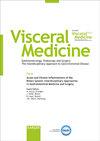Emergency Surgery for Acute Complicated Diverticulitis
引用次数: 8
Abstract
Background: The optimal treatment of acute complicated diverticulitis is a matter of debate and has undergone significant changes. Currently, the main focus of surgical treatment concepts is on controlling the emergency situation triggered by acute complicated sigmoid diverticulitis through interventional and minimally invasive measures. Methods: This article presents the current data and recommendations on differentiated treatment of acute complicated sigmoid diverticulitis, which are also summarized in a decision tree. Results: In general, resection of the diverticular sigmoid is needed to treat acute complicated sigmoid diverticulitis, because without resection the recurrence rate is too high at 40%. Since the morbidity and mortality rates associated with emergency resection are extremely high, resulting in the creation of a stoma, efforts are made to control the acute situation through interventional and laparoscopic measures. Therefore, pericolic and pelvic abscesses (Hinchey stages I, II) are eliminated through percutaneous or laparoscopic drainage. Likewise, laparoscopic lavage and drainage are performed for purulent and feculent peritonitis (Hinchey stages III, IV). After elimination of the acute septic situation, interval elective sigmoid resection is conducted. If emergency resection cannot be avoided, it is performed, while taking account of the patient's overall condition, with primary anastomosis and a protective stoma or as discontinuity resection using Hartmann's procedure. Conclusion: Thanks to the progress made in interventional and laparoscopic treatment, differentiated concepts are now used to treat acute complicated sigmoid diverticulitis.急性复杂性憩室炎的急诊外科治疗
背景:急性复杂性憩室炎的最佳治疗是一个有争议的问题,并发生了重大变化。目前,外科治疗理念的主要焦点是通过介入和微创措施控制急性复杂乙状结肠憩室炎引发的紧急情况。方法:本文介绍急性复杂乙状结肠憩室炎的临床资料及鉴别治疗建议,并以决策树的形式进行总结。结果:急性复杂乙状结肠憩室炎不切除复发率高达40%,一般需行乙状结肠憩室切除术。由于与紧急切除相关的发病率和死亡率极高,导致造口,因此通过介入和腹腔镜措施努力控制急性情况。因此,通过经皮或腹腔镜引流消除心包和盆腔脓肿(Hinchey期I, II)。脓性、粪性腹膜炎同样行腹腔镜灌洗引流(Hinchey III期、IV期)。急性脓毒症消除后,行间隔选择性乙状结肠切除术。如果不能避免紧急切除,则在考虑患者整体情况的情况下,进行初级吻合和保护性造口,或采用Hartmann手术进行间断切除。结论:随着介入和腹腔镜治疗技术的进步,急性复杂乙状结肠憩室炎的治疗已逐渐采用差异化的概念。
本文章由计算机程序翻译,如有差异,请以英文原文为准。
求助全文
约1分钟内获得全文
求助全文

 求助内容:
求助内容: 应助结果提醒方式:
应助结果提醒方式:


